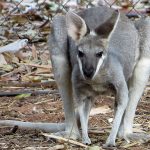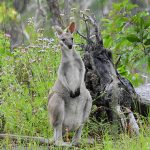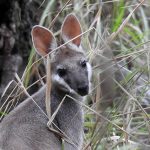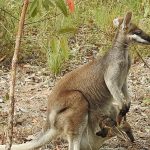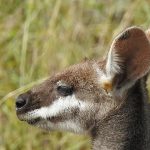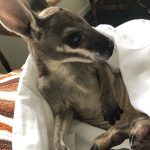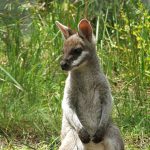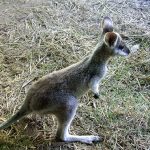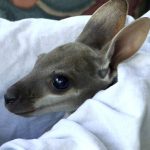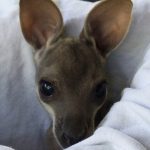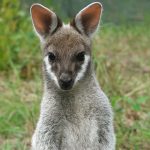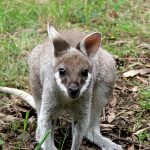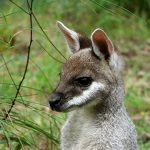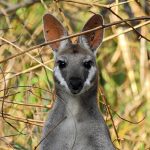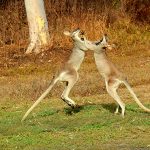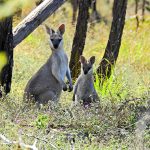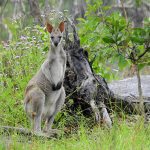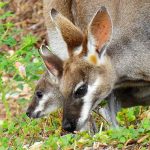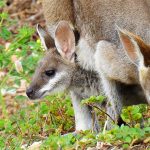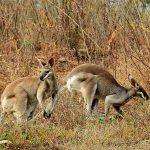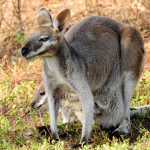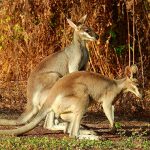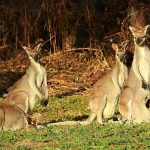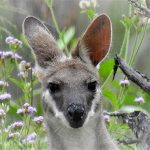WHIPTAIL WALLABY
The Whiptail Wallaby: Nature’s Blue Flier
Imagine the soft light of dawn illuminating rolling hills in eastern Australia. Among the shadows, a group of wallabies grazes quietly. Each one bears a delicate palette of pale browns and greys, accented by a bright white underbelly and elegant stripes—a sight as gentle as it is striking. Meet the Whiptail Wallaby, often known as the Blue Flier for the bluish sheen sometimes seen on its coat, and the Pretty-Face Wallaby for its refined facial markings.
Physical Features
- Distinctive Stripe: A chocolate-brown band traces smoothly from the neck to shoulder, sharply contrasted by crisp white lines along the hips and upper lip.
- Size and Weight: Adult males weigh in between 14–26 kg, with females being lighter, at 7–15 kg—a pronounced example of sexual dimorphism.
- Youthful Appearance: The soft contrast on the face and flanks gives them a delicate, almost ethereal presence.
Fascinating Facts & Behaviours
1. A Tale of Two Timelines
- Females mature at 18–24 months, ready to nurture the next generation sooner than the males.
- Males must wait 2–3 years to reach maturity, as dominance and social order shape their development.
2. A Pouch Life
- The gestation period is surprisingly brief, just 34–38 days.
- Once born, the pea-sized joey climbs unaided into its mother’s pouch, where it remains for a cosy 37 weeks.
- Even after leaving the pouch, it will return to nurse for around 15 months.
3. Social Symphony
- They gather in loose but cohesive groups of up to 50 individuals.
- These mobs are a lively mix of ages and genders, reflecting the complex interplay of wallaby society.
- Social connections help in spotting predators and learning foraging routes.
4. Habitat Harmony
- Found in the hilly forests and grasslands of Northern NSW, Southern Queensland, and up to Cooktown, Whiptail Wallabies flourish where native grasses abound.
- They play a gentle ecological role, helping manage grass growth and maintaining balance in their ecosystems.
5. Dawn and Dusk Dwellers
- Whiptail Wallabies are crepuscular—most active when light is softest, at dawn and dusk.
- Their primary diet consists of grasses, but they will also graze on ferns and native herbs, their movements quiet and almost meditative in the early morning mist.
Multi-Sensory Experience
Picture the gentle rustle of grass underfoot as a wallaby bounds softly across the dew-laden earth. The air is earthy and sweet, tinged with the fresh scent of eucalyptus. From a distance, you can hear their faint, rhythmic foraging—an emblem of tranquillity in the waking bush.
Conservation Insights
While currently not threatened, the Whiptail Wallaby relies on the preservation of native forests and grasslands. Clearing land and habitat fragmentation pose ongoing challenges.
Impact of Meat Slaughter
Historically, and still in some regions today, Whiptail Wallabies have been harvested for meat and hides. While not as commonly targeted as larger kangaroo species, they have nonetheless been included in culling practices and commercial harvests. This hunting has had several impacts:
- Population Pressure: In areas where harvesting ( shooting) takes place, local populations have declined.
- Affected Social Groups.
Group Disruption and Its Effects on Whiptail Wallaby Populations
The Social Web of Wallabies
Whiptail Wallabies are naturally social creatures, living in interconnected groups called mobs that can comprise up to 50 individuals. Within these groups, wallabies establish a network of social bonds and hierarchies, especially during breeding seasons and while raising young.
How Group Disruption Occurs
When wallabies are harvested or culled—whether for meat, hides, or population management—entire family groups can be disrupted. This is because harvesting typically does not select individuals based on their role within the group, and can lead to:
- Loss of dominant males who maintain group order and breeding rights.
- Removal of mothers and joeys, disrupting nurturing and learning.
- Breakdown in age and sex balance, which is crucial for healthy breeding cycles.
Impact on Population Dynamics and Breeding Success
1. Reduced Breeding Efficiency
- Social structure helps determine which males breed and protect the group. If dominant males are removed, inexperienced or immature males may take over, potentially leading to lower genetic diversity and unstable group dynamics.
2. Increased Stress and Movement
- Wallabies rely on group vigilance to watch for predators. Disrupting this increases stress, makes individuals more vulnerable, and may cause them to leave familiar areas, leading to lower survival rates.
3. Orphaned Joeys
- When female wallabies are culled, dependent joeys may be left without care, dramatically reducing their survival.
4. Population Declines and Fragmentation
- Frequent or intense harvesting can outpace the wallaby’s natural reproduction rate, potentially causing local declines.
- Disrupted groups may split or migrate unpredictably, affecting not just wallaby numbers but also the broader ecosystem.
Conservation Perspective
Maintaining stable group structures is vital for long-term population health. Responsible management practices—such as stopping the cruel “harvesting” can help ensure populations remain resilient.
Ultimately, understanding and respecting the social nature of Whiptail Wallabies is key to their conservation. Each group is more than a collection of individuals; it is a living, interacting unit essential for the survival and flourishing of this enchanting Australian species.
- Legal Protections: In some states, regulations have been enacted to safeguard population viability. However, illegal and unregulated hunting has contributed to local stress on wallaby numbers.
Today, the Whiptail Wallaby’s overall conservation status is officially regarded as stable, but their ongoing survival depends on careful management and continued monitoring, particularly in regions where hunting or habitat clearing persist.
Safeguarding these marsupials also helps protect countless other species that share their environment.
Interesting Facts Table
| Aspect | Detail |
|---|---|
| Alternate Names | Blue Flier, Pretty-Face Wallaby |
| Scientific Name | Macropus parryi |
| Social Structure | Groups (mobs) up to 50 |
| Iconic Feature | Brown and white striping; blueish coat shine |
| Diet | Grasses, ferns, native plants |
| Range | NSW, QLD, up to Cooktown |
| Conservation Status | Least Concern but vulnerable to habitat loss and both legal and illegal shooting. |
The Whiptail Wallaby is not just a stunning sight in the Australian wild. It is a living story—one of family loyalties, dawn journeys, and intricate connections to place. Through conserving their habitats, we preserve more than a species; we safeguard a piece of Earth’s natural heritage, inviting future generations to discover the magic of the bush.
Want to help protect wallabies?
Support local conservation groups, learn about habitat restoration, and share what you’ve discovered—each action adds another thread to the rich tapestry of Australian wildlife.
Photo Gallery
Sharon: Camping by a pristine creekline on the Tablelands in Northern Queensland, Australia, we had some unexpected neighbours drop by. They were the beautiful Whiptail Wallabys. They are one of our prettiest Wallabies and this gave me to see these iconic ‘Aussie Critters’ up close.

